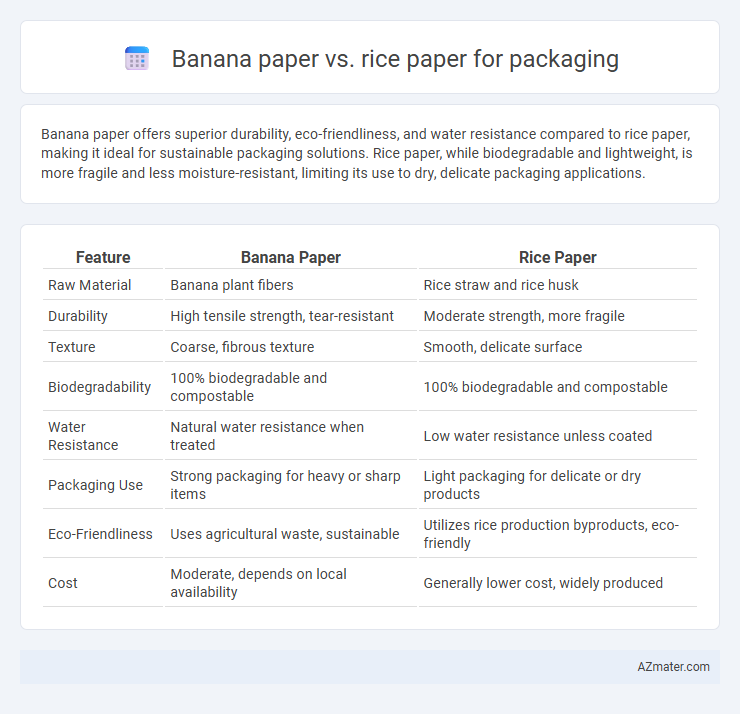Banana paper offers superior durability, eco-friendliness, and water resistance compared to rice paper, making it ideal for sustainable packaging solutions. Rice paper, while biodegradable and lightweight, is more fragile and less moisture-resistant, limiting its use to dry, delicate packaging applications.
Table of Comparison
| Feature | Banana Paper | Rice Paper |
|---|---|---|
| Raw Material | Banana plant fibers | Rice straw and rice husk |
| Durability | High tensile strength, tear-resistant | Moderate strength, more fragile |
| Texture | Coarse, fibrous texture | Smooth, delicate surface |
| Biodegradability | 100% biodegradable and compostable | 100% biodegradable and compostable |
| Water Resistance | Natural water resistance when treated | Low water resistance unless coated |
| Packaging Use | Strong packaging for heavy or sharp items | Light packaging for delicate or dry products |
| Eco-Friendliness | Uses agricultural waste, sustainable | Utilizes rice production byproducts, eco-friendly |
| Cost | Moderate, depends on local availability | Generally lower cost, widely produced |
Introduction to Eco-Friendly Packaging Solutions
Banana paper, made from banana plant fibers, offers a sustainable and biodegradable alternative to traditional packaging materials, reducing deforestation and waste. Rice paper, derived from rice straw and husks, also provides eco-friendly packaging by utilizing agricultural byproducts that would otherwise be discarded. Both materials contribute to eco-conscious packaging solutions by minimizing environmental impact and promoting resource efficiency.
What is Banana Paper?
Banana paper is an eco-friendly material made from banana plant fibers, offering durability and biodegradability ideal for sustainable packaging solutions. It provides a sturdy alternative to traditional papers, with natural resistance to tearing and moisture, enhancing product protection. Unlike rice paper, which is thinner and more delicate, banana paper supports heavier packaging needs while reducing environmental impact.
What is Rice Paper?
Rice paper is a biodegradable, thin material traditionally made from the starch of rice flour, often combined with other natural fibers like bamboo or hemp for enhanced strength. It is widely used in packaging due to its lightweight, flexible, and environmentally friendly properties, making it an excellent alternative to plastic wraps. Compared to banana paper, rice paper offers a smoother texture and translucency, ideal for delicate products, while still maintaining strong moisture resistance.
Production Processes: Banana Paper vs Rice Paper
Banana paper production utilizes banana plant fibers derived primarily from agricultural waste, involving a process of retting, pulping, and sheet forming that emphasizes sustainability by repurposing non-food biomass. Rice paper production, traditionally made from rice straw or the pith of rice plants, requires steaming or soaking the fibers before being pressed into thin sheets, often relying on water-intensive methods and sometimes chemical treatments. The eco-friendliness and durability of banana paper are often highlighted in packaging applications, as its production minimizes resource consumption compared to the comparatively water-heavy and delicate manufacturing process of rice paper.
Environmental Impact Comparison
Banana paper, made from banana plant fibers, offers a highly sustainable packaging option due to its biodegradability and the use of agricultural waste, reducing deforestation and landfill impact. Rice paper, derived from rice straw or pith, also biodegrades easily but relies on crop residues that may compete with other agricultural uses, potentially affecting resource allocation. Both materials significantly lower carbon footprints compared to plastic, yet banana paper's utilization of banana waste gives it a slight edge in circular economy principles and waste valorization.
Physical Properties and Durability
Banana paper exhibits higher tensile strength and better tear resistance compared to rice paper, making it more suitable for durable packaging applications. Rice paper tends to be thinner and more fragile, offering excellent biodegradability but limited protection against moisture and mechanical stress. The fiber structure in banana paper provides enhanced durability and flexibility, ensuring longer-lasting packaging performance.
Cost Analysis: Which is More Economical?
Banana paper generally costs more upfront than rice paper due to the specialized processing of banana fibers and limited production scale. Rice paper benefits from widespread availability and traditional mass production methods, making it more economical for large-volume packaging needs. However, banana paper's durability and eco-friendly properties can offer cost savings in long-term sustainability efforts and brand differentiation.
Suitability for Different Packaging Needs
Banana paper offers excellent durability and eco-friendliness, making it ideal for sustainable packaging of heavier or moisture-prone products. Rice paper is lightweight and flexible, best suited for delicate or dry items requiring breathable packaging. Choosing between banana and rice paper depends on product protection needs, weight, and environmental considerations.
Consumer Perceptions and Market Trends
Banana paper, valued for its eco-friendly appeal and durability, increasingly attracts environmentally conscious consumers seeking sustainable packaging options. Rice paper, known for its lightweight and biodegradable properties, remains popular in markets prioritizing natural aesthetics and traditional uses. Market trends indicate a growing preference for banana paper in premium packaging sectors due to its unique texture and strength, while rice paper maintains steady demand in food and craft industries.
Future Prospects: Banana Paper and Rice Paper in Packaging
Banana paper offers significant sustainable advantages due to its biodegradability and use of agricultural waste, making it a promising material for eco-friendly packaging solutions. Rice paper, valued for its lightweight and versatile properties, continues to evolve with enhanced durability and moisture resistance, expanding its applications in food and luxury packaging. Both materials are poised to gain market traction as industries increasingly prioritize renewable, biodegradable alternatives to traditional plastic packaging.

Infographic: Banana paper vs Rice paper for Packaging
 azmater.com
azmater.com